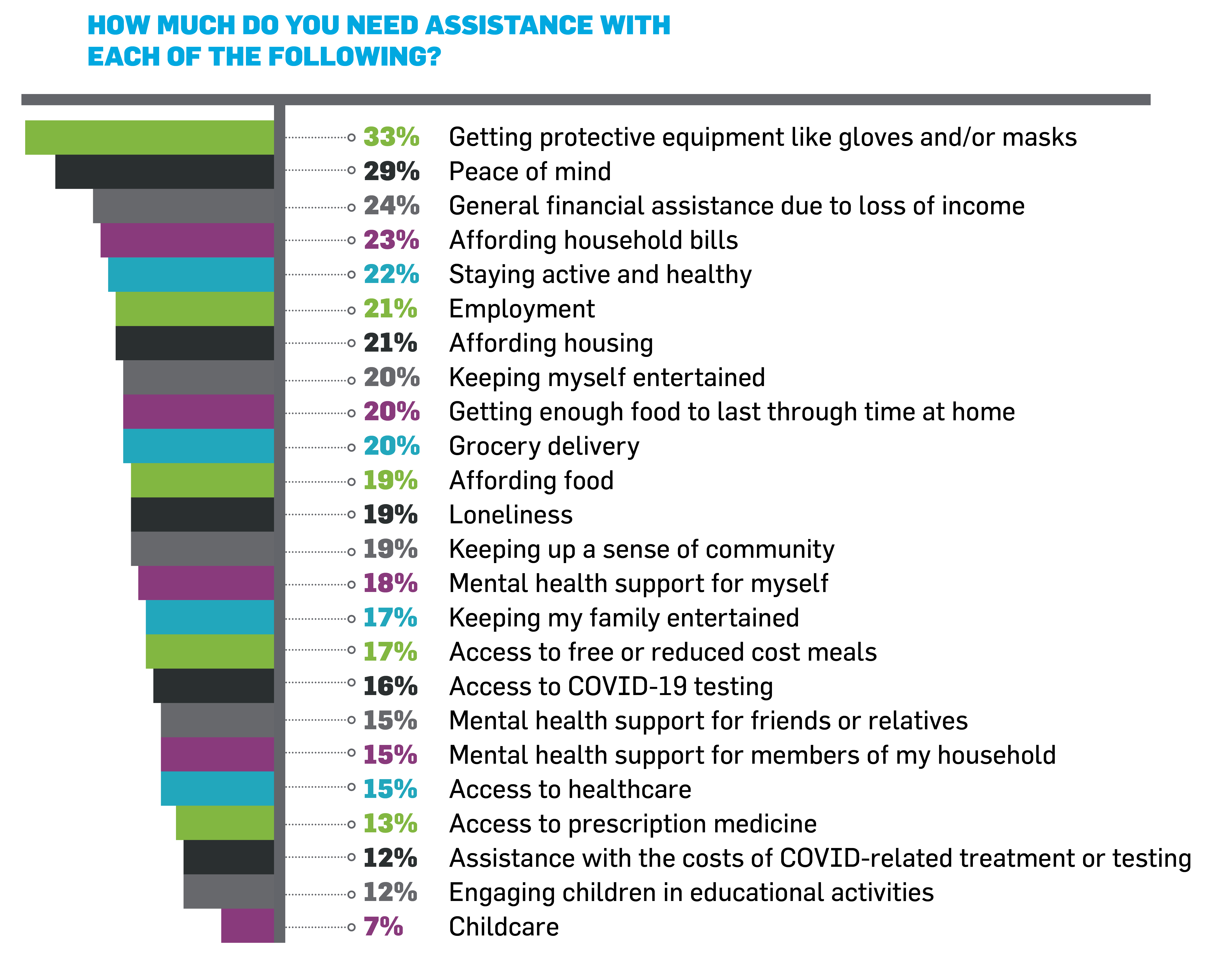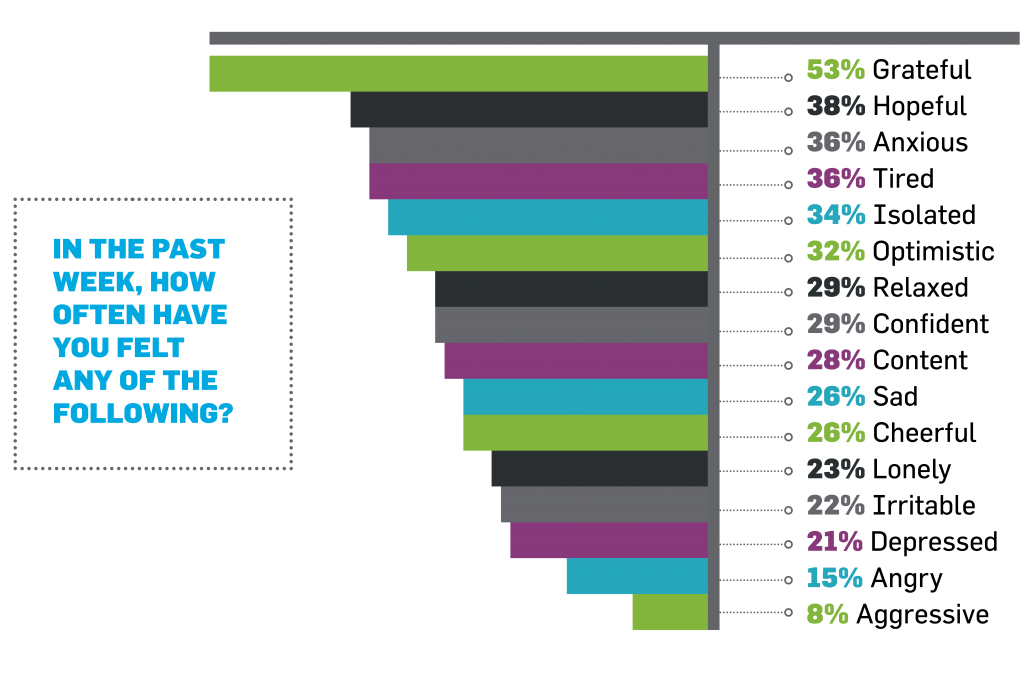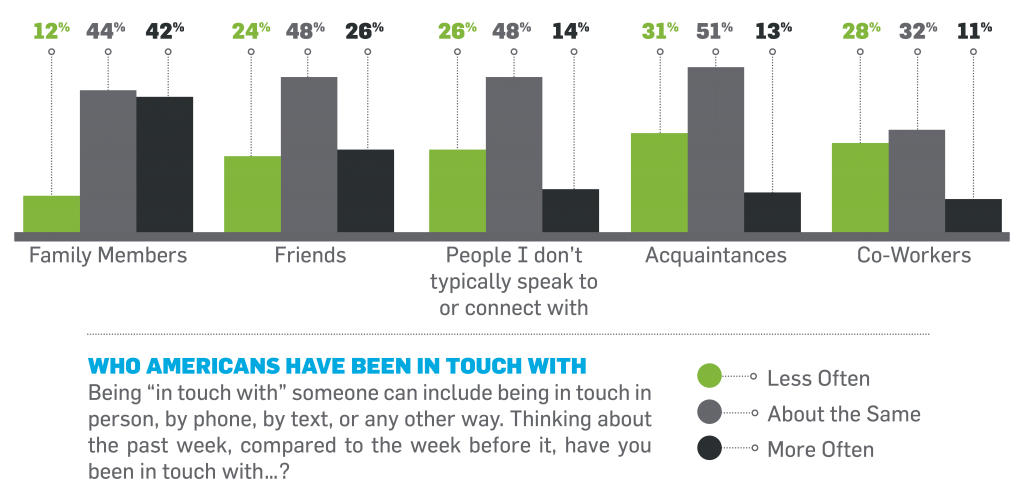KEY FINDINGS
Brief 1: 4.8.20
FINDING 1
Four in five Americans are financially impacted by the COVID-19 crisis.
The vast majority (79%) of Americans say they already have been financially impacted at least a little by COVID-19 as of early April 2020, and nearly one in four have experienced a very large financial impact. So far, the impact seems to decrease with age, as the majority of all respondents ages 18-34 report they’ve already been impacted (86%) - compared to 65% of those aged 65 and up.

Differences can also be seen by geography, and by race/ethnicity. Almost a quarter (23%) of Midwesterners report no financial impact from COVID-19 so far, compared to just 17 percent of respondents in the Northeast. And people of color report a greater financial impact than those who are white/Caucasian: Nearly a fourth (23%) of white/Caucasian respondents report no financial impact to date, compared to 15 percent of non-white/non-Caucasian respondents.
Beyond demographics, a strong correlation is already emerging between emotional state and financial impact. Ninety percent of respondents who are emotionally struggling (e.g., feeling sad, isolated, anxious, depressed and/or lonely most or all of the time) or angry/upset (e.g., feeling aggressive, angry and/or irritable most or all of the time) report at least a little financial impact so far, compared to 76 percent of emotionally content stable respondents (e.g., respondents who said they feel content, optimistic, relaxed, cheerful, confident, hopeful and/or grateful most or all of the time).
Social Insights
Online mentions of expense worries surged in mid-March, following President Trump’s declaration of a National State of Emergency on March 13, 2020. Mentions continued to climb as U.S. cities began imposing social distancing restrictions, and the stock market continued to suffer. An all-time high in mentions emerged on April 1st – the rent deadline for many Americans.

Similar to survey findings, younger generations appear to be experiencing the greatest impact, as 85% of all mentions stemmed from those ages 18-34. In line with the survey findings, a correlation emerged between emotional state and financial impact, with online expense worries having a strong relationship with negative personal expressions.
FINDING 2
Three in four Americans don’t know anyone who has been infected.
Despite the rate COVID-19 is spreading throughout the United States, as of the survey for this report (fielded April 3-5, 2020), only a quarter (24%) of Americans know someone who has or has had COVID-19, or has/had it themselves. This figure greatly differs by location: Half as many respondents in the West (18%) compared to the Northeast (38%) know someone who has/had the virus. (Respondents in the Midwest and South are similar to general data, as 23% and 22% respectively report knowing someone who has/had COVID-19.)
FINDING 3
Americans most need personal protective equipment (PPE) and peace of mind.
When asked to rate how much they need immediate assistance with various categories, two items stood out the most among respondents:
- Getting protective equipment (PPE) like gloves/masks (33%)
- Peace of mind (i.e., knowing or feeling comfortable and/or stable) (29%)
Coming in third (though slightly lower on the list) is general financial assistance due to loss of income (24%), followed by affording household bills (23%) and staying active and healthy (22%). On the lower end of the spectrum? Mental health support (15%) and access to healthcare or prescription medicine (15% and 13%), assistance with COVID-related treatment or testing (12%), engaging children in educational activities (12%) and childcare (7%).
Across the board, people of color report needing immediate assistance more than white/Caucasian respondents. For example, while getting PPE tops the list for all respondents as their most immediate need, nearly half (45%) of non-white/non-Caucasian respondents report needing immediate assistance, compared to a quarter (27%) of those who are white/Caucasian. A third (34%) of non-white/non-Caucasian respondents report the immediate need of peace of mind, compared to 26 percent of white/Caucasian respondents. Similar disparities can be seen throughout each category.

FINDING 4
Americans are most worried about the economy, the health of frontline workers, and people not taking the pandemic seriously.
Three categories top the list for what Americans are currently most worried about: the economy (69%), the health of medical and other frontline workers (68%), and people not taking COVID-19 seriously (66%). Coming in fourth on the list is the health of friends or family members (53%), and after that - with a substantial drop - is respondents’ own health (34%).

As the region most affected by the pandemic thus far, Northeasterners are most worried about people taking the crisis seriously and the health of medical and other frontline workers (71% each). On the opposite side of the country, respondents in the West are most worried about the economy (73%).
Even further, those who know someone who has/had COVID-19 are significantly more worried than Americans overall, across all categories. In the top three categories, eight in 10 of those who know someone who has/had COVID-19 are worried about the health of medical and other frontline workers (80%) and people taking COVID-19 seriously (75%), compared to two-thirds (64% each) of those who don’t know someone with the virus.
Social Insights
Economic concerns were reinforced on social media, as online worries over the economy soared in mid-March alongside significant drops in the Dow Jones.

FINDING 5
Americans want to know when the crisis will end, and when a vaccine will be available.
Respondents mostly feel that they have the right amount of information about COVID-19-related topics, except two important factors: when the pandemic will end, and when the vaccine will be available. Nearly two-thirds (64%) of Americans say they need more information on when the COVID-19 crisis will end, and 59 percent want to know when a vaccine will be available. Other notable findings:
- Four in 10 respondents (41%) want more clarity on what’s true and what’s false about COVID-19.
- A third of respondents (35%) want more information on how to help or support healthcare workers.
Three in four Americans say they have sought out information about COVID-19 in the past week. The top news source for nearly half of respondents (47%) was TV news. The next popular news sources were the CDC (37%), online news sources (36%), NIAID Director Dr. Anthony Fauci (32%) and local government sources (28%).

FINDING 6
Americans are grateful and hopeful (yet anxious and tired).

Respondents most report feeling grateful (53%) and hopeful (38%) -- though more than a third are also anxious and tired (36% each). Aggressive and angry feelings are at the bottom of the list.
FINDING 7
Americans are connecting more.
Despite “stay at home” orders, people are staying connected more often than usual. In the past week, 87 percent of respondents reported being about the same or more “in touch” (in person, via phone/text or other means) with family members compared to the week before. This spans beyond family, too: 74 percent report being the same or more in touch with friends, 64 percent with acquaintances, 62 percent with people they don’t typically speak to or connect with, and 43 percent with coworkers.

Social Insights
In light of the nation’s social distancing efforts, video conferencing and “virtual happy hours” have become the new normal for connecting with family, friends and co- workers. Zoom, a popular video conferencing platform, experienced substantial liftsin usage mentions, up until privacy concerns emerged over the past few days.


